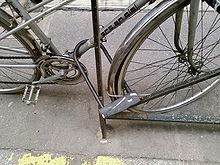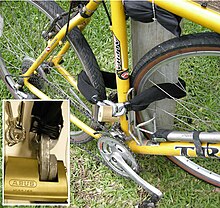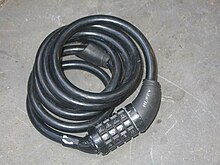This is an old revision of this page, as edited by Rpo.castro (talk | contribs) at 07:59, 6 September 2024 (Can see the relevance of adding an article of a brand to the see also category. See also is not a list of brands). The present address (URL) is a permanent link to this revision, which may differ significantly from the current revision.
Revision as of 07:59, 6 September 2024 by Rpo.castro (talk | contribs) (Can see the relevance of adding an article of a brand to the see also category. See also is not a list of brands)(diff) ← Previous revision | Latest revision (diff) | Newer revision → (diff) Type of lock used to secure bikesThis article has multiple issues. Please help improve it or discuss these issues on the talk page. (Learn how and when to remove these messages)
|

A bicycle lock is a security device used to deter bicycle theft, either by simply locking one of the wheels or by fastening the bicycle to a fixed object, e.g., a bike rack.
Locking devices vary in size and security, the most secure tending to be the largest, heaviest and least portable. Thus, like other security equipment, bicycle locks must balance the competing interests of security, portability, and cost. Some are made of particularly expensive materials chosen for their acceptable strength and low density.
Types
U-locks and D-locks

A U-lock is a rigid metal ring in the shape of the letter U. The U part of the lock attaches to a crossbar section, and for this reason they are also called D-locks. To lock the bicycle, one locks it physically to some other object, such as a bike rack, parking meter or other pole installed securely in the solid ground. Merely locking the bike frame to the wheel is not recommended because, although it cannot be rolled away, the entire bicycle can still be lifted and carried away.
U-locks are more secure than most other kinds of locking mechanism because they are more resistant to cutting with high-leverage hand tools such as bolt cutters. A common brute force method to break open U-locks is to use a long length (perhaps 2 metre) of pipe to twist the lock open (although this method is more commonly used to defeat chain and cable locks).

Chain
A chain lock is a chain with a lock. It often has a key or a combination lock attached to it. A long enough chain can pass through both wheels, the frame and attach the bicycle to an immovable object. Because of their inherent flexibility, chains are easier to secure around tricky-shaped objects than D-locks.
Chains vary widely in their security level. If the chain is bought from a hardware store, it is most likely made from basic iron or steel and can easily be cut with a relatively inexpensive pair of bolt cutters. Chains specifically designed for bike security are often case hardened and may feature Hexagonal or Trapezoidal link surfaces more impervious to hand tools.
A chain is only as strong as its weakest link, which may be the lock itself. Although a cheap keyed or combination lock may be an appropriate match for a hardware store chain, a case-hardened security chain necessitates a specialized lock such as a monobloc padlock or mini u-lock. Compared to other locks, chains tend to be the heaviest solution, especially in the case of long and/or tough chains.
Cable locks



Cable locks are in many ways similar to chain locks. Cable locks often come with the locking mechanism already permanently integrated. Otherwise, a length of cable with loops on both ends can also be used.
The main advantage of cable locks over chains is the ease of transporting them. Simple cable locks, however, are only sufficient for use in low-risk areas. Even the largest diameter unprotected cable can be quickly cut with bolt cutters. More robust cable locks have overlapping steel jackets threaded over the cable. This can make it more difficult to cut the central cable.
Many cyclists use a long cable to secure bicycle components (such as the wheels or seat) in conjunction with a U-lock or padlock to secure the frame. Special strong cables are available which are made with a loop at each end continuous with the cable, which enable linking with a locking device.
A common design flaw among low-quality combination-lock cables allows thieves to peer into the grooves between the disks. This allows them to decipher the unlock combination while cycling through the individual numbers on each disk. Also, if the number of disks is low, the thief doesn't even need to peer into it and can simply use a brute-force attack (try every combination until it opens).
Wheel lock

Also called an O-lock, ring-lock or frame lock. This is a low security mechanism mounted on the frame that immobilizes the rear wheel by moving a steel bolt through the spokes to prevent motion.
An O-lock prevents riding the bicycle but does not, by itself, secure the bicycle to a stationary object. This type of lock is effective and convenient for securing a bicycle against opportunistic theft, when the bike is left unattended momentarily. It forces the thief to carry the bicycle. It is a common way to secure bicycles when someone is at home, if their company provides indoor bicycle parking, and at railway station parking.
The O-lock also conveniently secures the rear wheel: only locking the frame is needed, to secure both the frame and the rear wheel. Used in addition to a U-lock it can be a convenient second lock. Some models have an optional cable or chain that plugs into the body of the lock to enable the bicycle to be secured as well.
Smart locks
Smart locks use Bluetooth technology to allow a lock to be unlocked with a smartphone, and can send a notification if they are breached. Several smart bicycle locks have been produced through crowdfunding and sold as consumer products. Some bicycle-sharing systems also use them. Smart locks introduce added security risks through the possibility of hacking.
Disc rotor locks
Disc brakes are a popular braking system for bicycles, most notable for mountain bikes but recently there has been an increase in their popularity for road bikes, especially after the UCI approved them for use in professional races in May 2018.
Disc rotor locks have been popular for motorcyclists for many years but with the proliferation of bicycles now using them smaller, more compact versions for bicycles have been created. They work by inserting a metal pin through the hole in the disc rotor between the seatstay and chainstay, preventing the wheel from rotating and virtually immobilising the rear wheel. The locks themselves are small, metal devices that sit around the edge of the disc rotor and are locked with a key insertion.
Standards and tests
Test standards that rate the effective security of bicycle locks are provided by various companies and organizations, depending on location.
In the UK, a lock certified by Sold Secure or Thatcham is usually required in order to insure a bicycle or motorcycle against theft.
Tests carried out on behalf of Cycle magazine showed that all of the bicycle locks tested, which had a variety of certifications, could be broken in less than 42 seconds. Cables and chains were breached using either small cable cutters or 36″ bolt croppers, and D-locks were breached using a stubby bottle jack. Of the locks tested, five had a Sold Secure Gold rating, varying in price from £25 to £100. Two of these Gold rated locks withstood only 10 seconds of attack.
The Dutch consumer news show Kassa 3 published a four-minute show in which a former bicycle thief removed eight consumer-grade locks (cheaper than €30 / ≈$40) from a bike in times ranging from 10 to a maximum of 84 seconds. The locks included those from manufacturers ABUS, Hema and Halfords.
Effectiveness
See also: Sucker poleBicycle locks are only effective when they are used on secure objects. For example, a bicycle lock is useless when connected to a "sucker pole", which is a pole that gives the biker the appearance of security. A bicycle thief may target the bicycle because the pole can be quickly and easily dismantled, even in broad daylight.
See also
- Bicycle locker
- Bicycle parking
- Bicycle stand - also known as bicycle rack
- Bicycle tree
- Bicycle transportation engineering
- Bike registry
- Wheel clamp
References
- ^ Carlton Reid (February 2008). "Cycle Magazine: Gone in 42 seconds!" (PDF). Cyclists' Touring Club. pp. 42–46. Archived from the original (PDF) on 2016-02-16.
- ^ "Your U-Lock Is Basically Worthless, but Don't Worry". Bloomberg. 27 October 2014. Retrieved 2016-07-18.
- ^ "Lock it or lose it". QuickRelease.TV. 2008-02-14. Archived from the original on 2008-06-29. Retrieved 2008-07-10.
- Kerr, Dara (May 15, 2014). "Solar-powered Skylock smart bike lock offers security, sharing". CNET. Retrieved November 18, 2016.
- Lomas, Natasha (April 28, 2016). "Bitlock crowdfunded a smart bike lock in 2013. What happened next?". TechCrunch. Retrieved November 18, 2016.
- Reiner, Dan (29 July 2016). "New Rochelle to roll out bike-share program". The Journal News. Gannett. Retrieved 26 November 2016.
- Van Boom, Daniel (22 November 2016). "Japan is making bike-sharing a thing". CNet. Retrieved 26 November 2016.
- Wagenseil, Paul (7 August 2016). "75 Percent of Bluetooth Smart Locks Can Be Hacked". Tom's Guide. Retrieved 26 November 2016.
- ^ "Disc Brakes Are on the Verge of Taking Over Pro Racing in 2018". Bicycling. 2018-01-03. Retrieved 2018-06-29.
- "Lock breaching table". QuickRelease.TV. 2008-02-14. Archived from the original on 2009-05-14. Retrieved 2008-07-10.
- ^ Jalal Bouzamour. "Kassa3 - 'how to steal a bike'". Kassa (television program). Archived from the original on 2016-02-14.
External links
| Locks, locksmithing, lock picking, and security alarms | |
|---|---|
| Fundamental concepts | |
| Components and hardware | |
| Keys | |
| Mechanical locks | |
| Electronic locks | |
| Other lock types | |
| Lock picking | |
| Security alarms |
|
| Miscellaneous | |